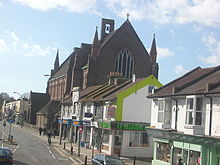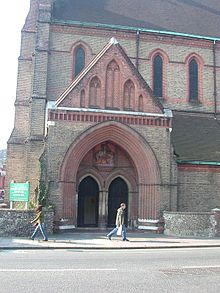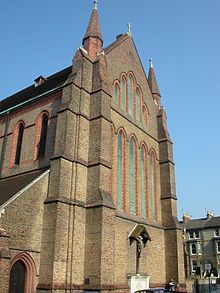- St Martin's Church, Brighton
-
For others churches dedicated to St. Martin, see St. Martin's Church (disambiguation).
St Martin's Church
East and south sides of St Martin's Church.Denomination Church of England Churchmanship High Church History Dedication St. Martin of Tours Administration Parish Brighton, St Martins Deanery Brighton Archdeaconry Chichester Diocese Chichester Province Canterbury St Martin's Church (in full, St Martin with St Wilfrid and St Alban) is an Anglican church in Brighton, England, dating from the mid-Victorian era. It is located on the Lewes Road (the present A270) in the Round Hill area of the city, northeast of the city centre and approximately 1.1 miles (1.8 km) north of the seafront. It is part of the parish of The Resurrection, together with St Luke's Church (on Queen's Park Road, further to the east) and the now redundant St Alban's Church (on nearby Coombe Road).
Contents
Selecting the site
Although the church was built between 1872 and 1875 and consecrated on 1 May 1875, its founding was closely connected with the former Vicar of Brighton, Rev. Henry Michell Wagner, who had served the town from 1824 until his death in 1870. He had been responsible for the construction of several churches during his period of office, including St. Peter's, which later became the town's parish church. At the time of his death, he was planning the construction of another, and had set aside £3,000 from his personal wealth, but had not decided on a location or any other details.[1]
Rev. Wagner's son, Arthur, had been ordained in 1850.[2] When his father died, Arthur inherited his wealth, and set out to build a church both to commemorate him and to fulfil the plans he had towards the end of his life. To achieve this, he convened with his half-brothers Joshua and Henry (junior) and decided on a site. The area chosen was largely under construction at the time, with large numbers of small terraced houses for poorer people being built to fill the space around the Lewes Road. Some of this development was funded by Arthur Wagner himself,[3] and as neither this area nor the nearby Round Hill district had a proper church, it was considered appropriate to finance and oversee the building of a church at the same time. (A small temporary church which had been built on a nearby street became a school when St. Martin's Church opened.)[3]
One action Rev. Henry Wagner had taken before his death was the creation of a "building committee", consisting of other prominent members of the local clergy. The three Wagners offered this committee a choice between constructing a new church on a site chosen by the committee members - in which case only the original £3,000 set aside for the project would be granted, with the committee paying for any work beyond this - and accepting a site chosen by the Wagners, in which case the brothers would bear the full cost. The committee decided to allow the Wagners to choose the site themselves; accordingly, a position on the west side of Lewes Road, just north of the bottom of Elm Grove, was selected.[4]
Construction
The first bricks were laid in October 1872. A building contractor named Jabez Reynolds, son of Jabez Reynolds senior who had built about 1,000 houses including many significant buildings in Brighton and Hove, including the Cliftonville[5] area of neighbouring Hove in the 1850s and 1860s, was chosen for the building work, while the architect was George Somers Leigh Clarke, a long-standing friend of the Wagner family: his father had been Clerk of the Vestry (the equivalent of a modern-day parochial church council) of Brighton since 1830, and had provided support to Rev. Henry Wagner during periods of tension between different sects and groups within the Vestry.[3]
Clarke (junior) studied under the prominent architect Sir George Gilbert Scott, and his other projects included a collaboration with J. T. Micklethwaite on the design of the new chancel at St. Peter's, the clerestory at St. Nicholas, work on Chichester Cathedral and an 8-year surveying role at St Paul's Cathedral, London.[3]
Design
The exterior of St. Martin's reflects the Gothic Revival interpretation of the Early English style associated with 13th century churches. Its most notable exterior feature is its considerable height, accentuated by the modest height of the majority of the surrounding buildings; brown brick, offset in some places with red, predominates on the outside, and the layout of the church is standard: an aisled nave with chapels on each side, and a chancel. A tower was included in the original plans, but was not built: a small bell-arch with a single bell was built instead, towards the north end. The church is on a north-south (liturgical east-liturgical west) alignment parallel with the Lewes Road.
The entrance, at the south end, is raised above the rest of the church, and there is an unimpeded view across the nave and into the chancel and beyond. Octagonal stone columns topped by brick arches separate the aisles from the nave; above these arches are a series of clerestory windows.[6] Twelve of these are stained glass.[7]
Although the marble altar is not original, dating from 1949, the large reredos above it is. It consists of 20 pictures and 69 statues, all of which were carved in the German town of Oberammergau, noted worldwide for its woodcarving tradition.[8] The original pulpit, dating from 1880, also remains: this, and the font in the raised entrance area, are decorated with materials from the collection of the late Rev. Henry Wagner. The base of the pulpit contains olive wood collected from the Mount of Olives; and the font, built of Sussex marble and installed in 1907, contains a variety of other stones and marble from sites such as Cairo and Pompeii, brought back to England by Rev. Wagner himself during his lifetime.[9]
Consecration, opening and later events
The Bishop of Chichester consecrated the church on 1 May 1875, and the vicar in charge of the temporary church nearby, Rev. R. I. Salmon, was appointed to the perpetual curacy of the new church by Rev. John Hannah, Rev. Wagner's successor as Vicar of Brighton.
Later in 1875, St. Martin's was granted its own parish: that of Brighton The Resurrection. This covers parts of the Lower Bevendean, Queen's Park, Round Hill and South Moulsecoomb areas.[10]
The Lady chapel was improved in 1925, the fiftieth anniversary of the consecration, as a memorial to Rev. Wagner, using money raised through a special collection. At the same time, part of the reredos was replaced.[11]
The church was closely connected with the former Preston Barracks, situated further up the Lewes Road in the north of the parish. A gallery was built on the east side of the chancel for troops and members of military bands to participate in services; also, two different regiments erected memorials to comrades killed in the Battle of Khartoum in 1884 and 1885.[12]
Organ
The organ at St. Martin's Church is a three-manual tracker action instrument, built in 1888 by the London firm of William Hill & Son—still named as such, despite the fact that William had died 18 years previously. The organ has 29 speaking stops; a full specification can be seen here. The present organist is Mr John Smee FASC FNMSM who was appointed in 1990 following a move from Cornwall, where he was an organist of St Budock Parish Church, Falmouth. Mr Smee is also Treasurer of the Parish, Foundation Governor of the Parish School and also Bursar to the North and Midland School of Music.
The church today
The church is a Grade II* listed building, defined as a "particularly significant building of more than local interest".[13][14] As of February 2001, it was one of 70 Grade II*-listed buildings and structures, and 1,218 listed buildings of all grades, in the city of Brighton and Hove.[15] A Sunday school operates every Sunday during term time. Sunday Mass takes place at 10.00am, with an Evening Prayer and Benediction service at 6.00pm. There is one service per day for the rest of the week, at 9.30am (Saturdays), 12.30pm (Wednesdays and Fridays) or 6.30pm (other days).[16]
See also
References
Notes
- ^ Dale 1989, p. 136.
- ^ Dale 1989, p. 90.
- ^ a b c d Dale 1989, p. 137.
- ^ Dale 1989, pp. 136–137.
- ^ "My Brighton and Hove: Introduction to Central Hove (History of Cliftonville)". http://www.mybrightonandhove.org.uk/page_id__5512.aspx.
- ^ Dale 1989, p. 138.
- ^ Dale 1989, p. 140.
- ^ Dale 1989, p. 139.
- ^ Dale 1989, pp. 139–140.
- ^ "A Church Near You: Parish information (Brighton, The Resurrection)". http://www.achurchnearyou.com/parish.php?p=10/38.
- ^ Dale 1989, p. 141.
- ^ Dale 1989, pp. 140–141.
- ^ "A Church Near You: Brighton, St. Martin's Church". http://www.achurchnearyou.com/venue.php?V=4810.
- ^ Details from listed building database (482030) . Images of England. English Heritage.
- ^ "Images of England — Statistics by County (East Sussex)". Images of England website. English Heritage. 2007. http://www.imagesofengland.org.uk/StatisticsPage/default.aspx?StatsCounty=EAST%20SUSSEX. Retrieved 31 January 2010.
- ^ "A Church Near You: Brighton, St. Martin's Church". http://www.acny.org.uk/venue.php?V=4810.
Bibliography
- Dale, Antony (1989). Brighton Churches. London EC4: Routledge. ISBN 0-415-00863-8.
External links
- Diocese of Chichester directory of churches: entry for St. Martin
- A Church Near You - entry for St. Martin
- National Pipe Organ Register - entry for St. Martin
Coordinates: 50°50′1″N 0°7′42″W / 50.83361°N 0.12833°W
Buildings and structures in Brighton and Hove Heritage Conservation areas · Listed buildings: Grade I · Grade II* · Grade II: A–B · C–D · E–H · I–L · M · N–O · P–R · S · T–V · W–Z




Places of worship List of places of worship (see list for links to individual articles) · List of demolished places of worship
Houses, flats
and mansionsChartwell Court · Embassy Court · Fife House · French Convalescent Home · 75 Holland Road · Marlborough House · New England Quarter · Ovingdean Rectory · Patcham Place · Pelham Institute · Preston Manor · Stanmer House · Sussex Heights · Van Alen Building · Western Pavilion
Crescents,
squares and
terracesAdelaide Crescent · Bedford Square · Belgrave Place · Bloomsbury Place · Brunswick Town · Hanover Crescent · Kemp Town · Lansdowne Square · Marine Square · Montpelier Crescent · New Steine · Norfolk Square · Norfolk Terrace · Old Steine · Oriental Place · Palmeira Square · Park Crescent · Pelham Square · Powis Square · Regency Square · Roundhill Crescent · Royal Crescent · Russell Square · Vernon Terrace · Wykeham Terrace
Commercial
buildingsAmex House · Brighton Forum, 95 Ditchling Road · Churchill Square · 20–22 Marlborough Place · 9 Pool Valley
Institutional and
civic buildingsBHASVIC · Brighton General Hospital · Brighton Town Hall · Hove Town Hall · Jubilee Library · Ovingdean Hall School · Royal Alexandra Hospital · Royal Sussex County Hospital · University of Sussex · Varndean College
Hotels and inns Hotels: Bedford · Grand (1984 bombing) · Metropole · Old Ship · Royal Albion · Royal York · Inns and pubs: The Cricketers · Evening Star · Freemasons Tavern · Hangleton Manor Inn · King and Queen · Royal Pavilion Tavern
Entertainment
and leisureAstoria (former) · Brighton Centre · Brighton Dome and Pavilion Theatre · Brighton Hippodrome (former) · Brighton Marina · Brighton Wheel · Duke of York's Picture House · Falmer Stadium · King Alfred Centre · Royal Pavilion · Saltdean Lido · Theatre Royal · Withdean Stadium · Museums: Booth Museum · Brighton Fishing Museum · Brighton Museum and Art Gallery · Brighton Toy and Model Museum · British Engineerium · Hove Museum and Art Gallery
Piers Brighton Pier · The Royal Suspension Chain Pier (demolished) · West Pier
Windmills Miscellaneous Barford Court · Chattri · Clock Tower · 11 Dyke Road · Foredown Tower · i360 (proposed) · Pepper Pot · St Dunstan's · Sassoon Mausoleum · Steine House (YMCA)
Related topics Ammonite Order · Bungaroosh · Cemeteries and crematoria · Mathematical tiles · Regency architecture · Architects: Charles Busby · John Leopold Denman · Thomas Lainson · John Nash · Basil Spence · Amon Henry Wilds · Amon Wilds
Categories:- 1870s architecture
- Church of England churches in Brighton and Hove
- Grade II* listed churches
- Grade II* listed buildings in Brighton and Hove
Wikimedia Foundation. 2010.







